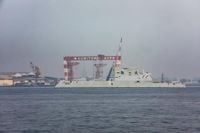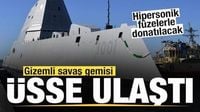The USS Michael Monsoor (DDG 1001), the second ship of the Zumwalt-class stealth guided missile destroyers, made a significant port call at Fleet Activities Yokosuka in Japan on July 7, 2025. This visit marks the first time since the USS Zumwalt’s historic 2022 deployment that a Zumwalt-class vessel has entered the Western Pacific, underscoring the U.S. Navy’s strategic focus on the Indo-Pacific region amid rising tensions.
Assigned to Destroyer Squadron 15 (DESRON 15), the largest destroyer squadron in the U.S. Navy, the Michael Monsoor joins a fleet usually composed of about ten Arleigh Burke-class destroyers. While these Arleigh Burkes are the Navy’s workhorses, the Zumwalt-class ships are larger and more technologically advanced, displacing nearly 15,000 tons compared to the Arleigh Burke’s smaller frame. However, despite their imposing size and stealthy design, the Zumwalt-class vessels have faced challenges in fulfilling their intended roles.
Originally designed to provide naval gunfire support with their large 155 mm Advanced Gun System (AGS) turrets, the ships’ forward-mounted guns have been inoperable for years due to budget constraints and exorbitant ammunition costs—each round costing between $800,000 and $1 million. This predicament left the Zumwalt-class without their signature firepower, relegating them to search for new missions. Fortunately, a breakthrough came in August 2023 when USS Zumwalt underwent a major overhaul at Huntington Ingalls Industries in Mississippi. The ship’s two AGS turrets were removed and replaced with four massive 87-inch diameter launch tubes, each capable of housing three hypersonic missiles. These weapons are variants of the U.S. Army’s Long-Range Hypersonic Weapon (LRHW), integrated through the Intermediate-Range Conventional Prompt Strike (IRCPS) program, enabling precision strikes at unprecedented speeds.
The USS Michael Monsoor is slated to receive similar modifications, while the third Zumwalt-class vessel, USS Lyndon B. Johnson, is being converted during its extended construction phase. Though the Monsoor currently lacks the hypersonic missile capability, its deployment to the Western Pacific provides critical operational experience for the ship’s crew, who may later serve on any of the three ships in forward-deployed roles.
Strategically, the Michael Monsoor’s arrival at Yokosuka Naval Base—a key U.S. installation near Tokyo that also hosts the aircraft carrier USS George Washington—comes on the heels of China’s recent naval exercises involving two aircraft carriers east of the so-called "first island chain." This chain, which includes Japan, Taiwan, and the Philippines, forms a vital line of defense for the United States in the Pacific. The timing of the Monsoor’s visit sends a clear signal of U.S. resolve and presence in a region increasingly marked by geopolitical competition.
Zumwalt-class destroyers are renowned not only for their stealth capabilities, which significantly reduce radar cross-section, but also for their advanced power generation systems. Powered by two Rolls Royce MT30 gas turbines—the same engines that propel the UK’s Queen Elizabeth-class aircraft carriers—the ships generate a staggering 78 megawatts of electrical power, with 58 megawatts available even at cruising speeds. This immense power capacity opens the door for integrating cutting-edge technologies such as directed energy weapons (DEWs), including high-energy lasers. The U.S. Navy has already deployed low-power laser systems on Arleigh Burke-class destroyers for defense against drones and missiles, but the Zumwalt’s power surplus could support more potent variants in the future.
While the Zumwalt-class was once eyed as a platform for experimental railguns—electromagnetic weapons capable of firing projectiles at extreme velocities—the U.S. Navy has since cut funding for railgun development in favor of missile-based solutions with longer ranges. Interestingly, Japan has recently made strides in this field, claiming to be the first nation to test-fire a railgun from a ship in 2023 and unveiling a prototype railgun on the JS Asuka test ship in July 2025. China has also claimed railgun testing, although concrete evidence remains elusive.
The USS Michael Monsoor’s presence in Japan is more than a routine port visit. According to the U.S. Seventh Fleet Public Affairs, such visits are essential for rest, refueling, replenishment, and repair, ensuring that naval forces remain ready to respond to any contingency. Yet, in the current geopolitical climate, these stops also serve as strategic demonstrations of U.S. commitment to allies and deterrence against regional threats.
Since departing Naval Base San Diego in March 2025, the Michael Monsoor has been actively forward-deployed in the Pacific, with a prior stop at Naval Base Guam in April. Whether the ship will return to San Diego after its Yokosuka visit or continue patrolling the contested waters around China remains to be seen. Regardless, its deployment underscores the Navy’s shift toward countering the growing influence of China in the Indo-Pacific.
The Zumwalt-class was conceived to bridge current naval needs with future capabilities, offering ample space and power reserves to accommodate systems not yet imagined. Their unique design and technological sophistication, combined with the integration of hypersonic weapons, position these ships as formidable assets in any high-end conflict scenario.
As The War Zone reported in early 2025, the hypersonic missiles slated for the Zumwalt-class represent a vital long-range strike capability, especially suited for targeting high-value strategic assets in a potential conflict with China. With speeds exceeding five times the speed of sound, these missiles offer a rapid, hard-to-intercept option that could reshape naval warfare dynamics.
In a region where military posturing has intensified, the arrival of the USS Michael Monsoor in Japan is a vivid reminder of the evolving maritime balance. Its stealth, firepower potential, and symbolic presence at a critical U.S. base reflect a nuanced blend of technological innovation and strategic signaling. As the Pacific theater continues to heat up, the Zumwalt-class destroyers stand at the forefront of America’s naval future, embodying both the challenges and ambitions of modern naval warfare.





